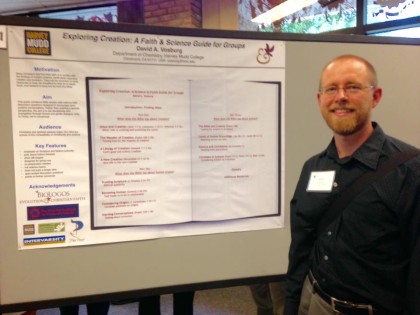
Earlier this summer, I had the privilege to attend BioLogos‘ Evolution & Christian Faith conference. It was easily the best experience I’ve had at an academic conference. Every day began and ended with a time of worship, singing the kinds of hymns you can really dig into, with the kind of accompaniment that encourages everyone to join in. I usually have a hard time talking to people at conferences, but everyone was very gracious and friendly so I got to have a lot of great conversations with new people. It was particularly exciting to meet several of my fellow ESN bloggers in person.
Since I enjoyed the conference so much, I’m really glad to be able to share some of the talks with you. Many of the presentations were recorded. There’s a lot of material on those pages; if you have the chance, I’d encourage you to explore the whole range of topics. I also thought I’d highlight a few presentations here.
Adam, Eve, and Second Adam
One of the big questions that comes up when trying to reconcile an evolutionary natural history with the Bible is how Adam and Eve fit in. So naturally there were a lot of talks on that question and related themes. John Walton gave a plenary talk on Genesis 2. He has done extensive study on the cultural context in which that part of Genesis was composed, and he shared how that informs his understanding of the passage.
ESN contributor Josh Swamidass shared his model for how Adam and Eve could be historical common ancestors even if they weren’t our sole progenitors. Taking both the scientific data and the Biblical texts seriously, his approach has a lot to recommend it.
When we talk about Adam and Eve, we are concerned about the Fall, which leads us to thinking about the redemptive work of Jesus. ESN contributor Mike Stell shared about the significance of the Incarnation as more than just a way to get to the cross, but also an end unto itself. Maybe because I’m a fan of John 1, I really like this understanding of the Incarnation. (Watch this space for more from Mike and myself.)
Divine Action
Another big question around an evolutionary natural history is whether it leaves any room for God. If we can describe the mechanism of creation using math, physics, chemistry and biology, does that mean God wasn’t involved? Jim Stump of BioLogos makes the case that a God-centric account of natural history isn’t at odds with a mechanistic one, nor does it simply fill in the gaps of the mechanistic account, but rather that both accounts can be complete unto themselves and also complementary.
Thomas Jay Oord gave a fairly comprehensive overview of the different ways that people understand how God interacts with the physical world. He also shared the details of his own approach to that topic. Even if you don’t agree with his particular, admittedly idiosyncratic, view, I think the talk is worth your time to explore the breadth of the topic. (Watch this space for further engagement with Thomas Jay Oord.)
Some housekeeping: Next week, some more from the BioLogos conference, focusing on some additional scientific questions. Coming soon, I will also be running a reader survey to make sure I am best serving your needs; I am not above offering prize(s) to encourage participation, so stay tuned for that. This fall, I’ll be mixing in some new kinds of posts along with the science news and commentary you’ve come to expect from me.
Andy has worn many hats in his life. He knows this is a dreadfully clichéd notion, but since it is also literally true he uses it anyway. Among his current metaphorical hats: husband of one wife, father of two teenagers, reader of science fiction and science fact, enthusiast of contemporary symphonic music, and chief science officer. Previous metaphorical hats include: comp bio postdoc, molecular biology grad student, InterVarsity chapter president (that one came with a literal hat), music store clerk, house painter, and mosquito trapper. Among his more unique literal hats: British bobby, captain’s hats (of varying levels of authenticity) of several specific vessels, a deerstalker from 221B Baker St, and a railroad engineer’s cap. His monthly Science in Review is drawn from his weekly Science Corner posts — Wednesdays, 8am (Eastern) on the Emerging Scholars Network Blog. His book Faith across the Multiverse is available from Hendrickson.

Leave a Reply